These Sourdough Dinner Rolls are soft and fluffy with a golden-brown crust brushed with melted butter. Sourdough and a long fermentation impart a deep and delicious flavor to these buttery rolls. They might steal the show at your next get-together.
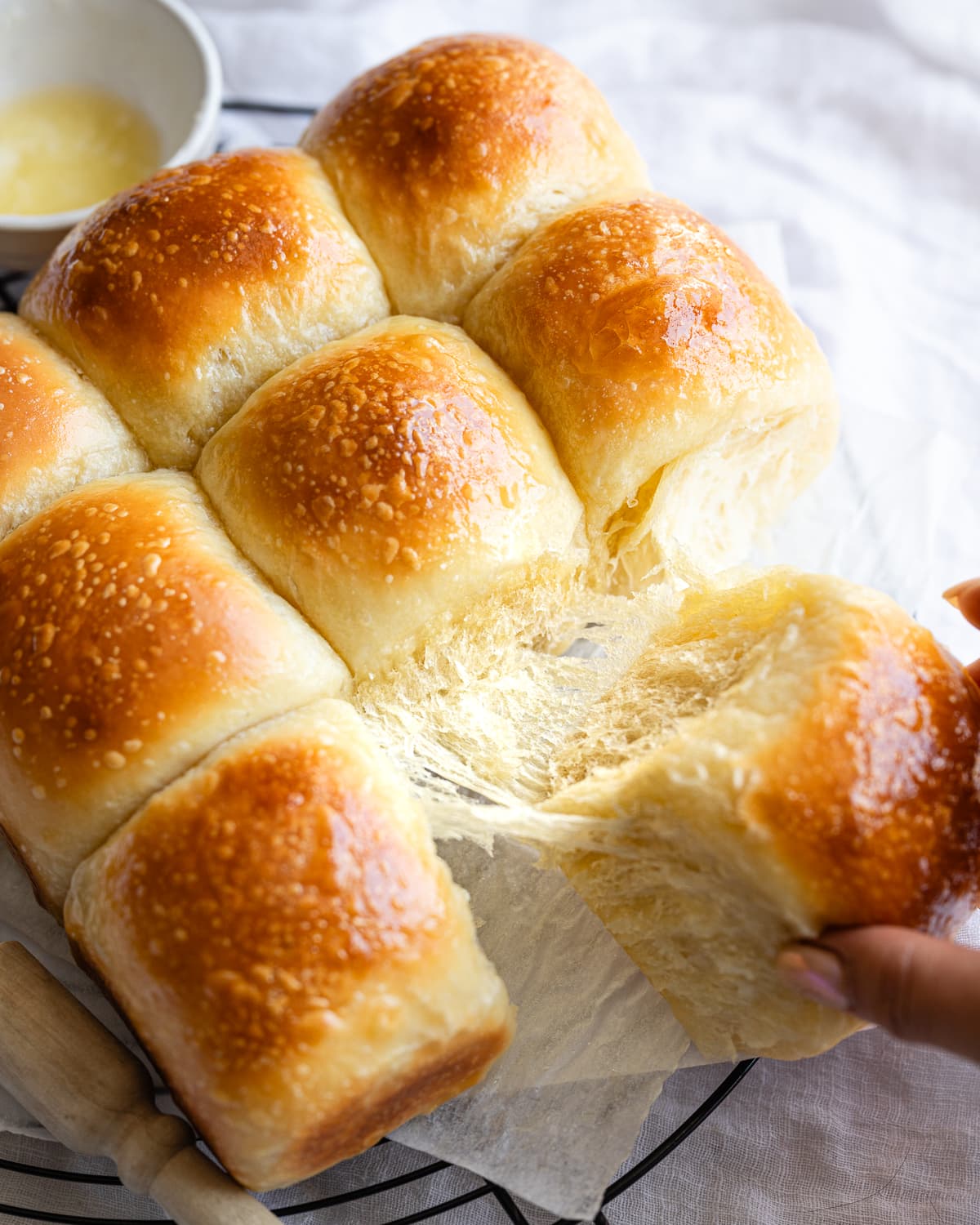
Few things can match the feeling of eating a homemade dinner roll and taking the time to make them from scratch takes every meal up a notch. That's why I put in the effort to perfect this sourdough dinner roll recipe before sharing it with you. I wanted these rolls to be worthy of a spot on your dinner table, whether it's a summer BBQ, Thanksgiving feast, birthday celebration, or Christmas dinner. The aroma of these buttery sourdough rolls is simply irresistible, and I promise, they'll have everyone clamoring for every last bite.
Jump to:
What makes these rolls so special
These rolls are extra special because they are made with sourdough instead of commercial yeast. Aside from the delicious and distinctive flavor that it imparts, sourdough also makes bread healthier and easier to digest. That’s because sourdough ferments dough much slower than commercial yeast, so while this means that the process to make these rolls is a bit longer (about 2 ½ days), the results are totally worth it.
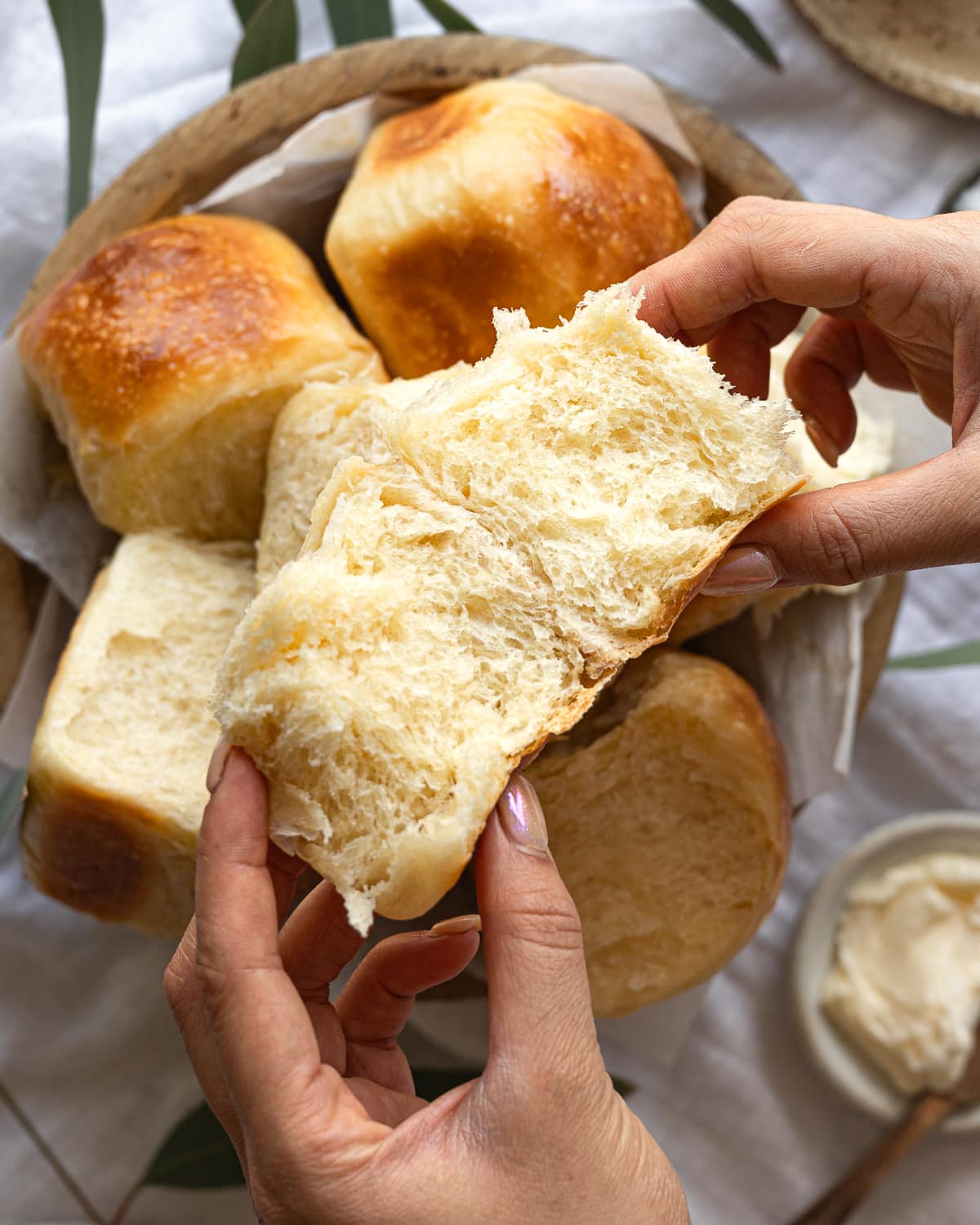
Benefits of sourdough and long fermentation
During fermentation, wild yeast consumes the sugar in flour, producing carbon dioxide that leavens the dough and ethanol, which imparts the distinctive flavors and aromas in freshly-baked bread that we know and love.
During the long fermentation process, bread gains a depth of flavor that can't be achieved with rolls made only with commercial yeast. In addition, wild yeast effectively pre-digests flour, reducing the impact of phytic acid found in grains. Essentially, yeast acts as a second stomach, unlocking nutrients in wheat—like magnesium, iron, and zinc—that humans typically struggle to absorb. It's a boost for both taste and nutrition.
Short on time but still want fresh bread? Try out my Sourdough Discard Rolls, Sourdough Discard Hot Dog Buns and Sourdough Discard Sandwich Bread.
Why I love this recipe
- The dough is mixed by hand - no special equipment required!
- Rolls have a soft and pillowy texture.
- Naturally-leavened with sourdough starter (no commercial yeast).
- Versatile dough that can be made into Sourdough Hamburger Buns or rolled into a Sourdough Babka!
What you need
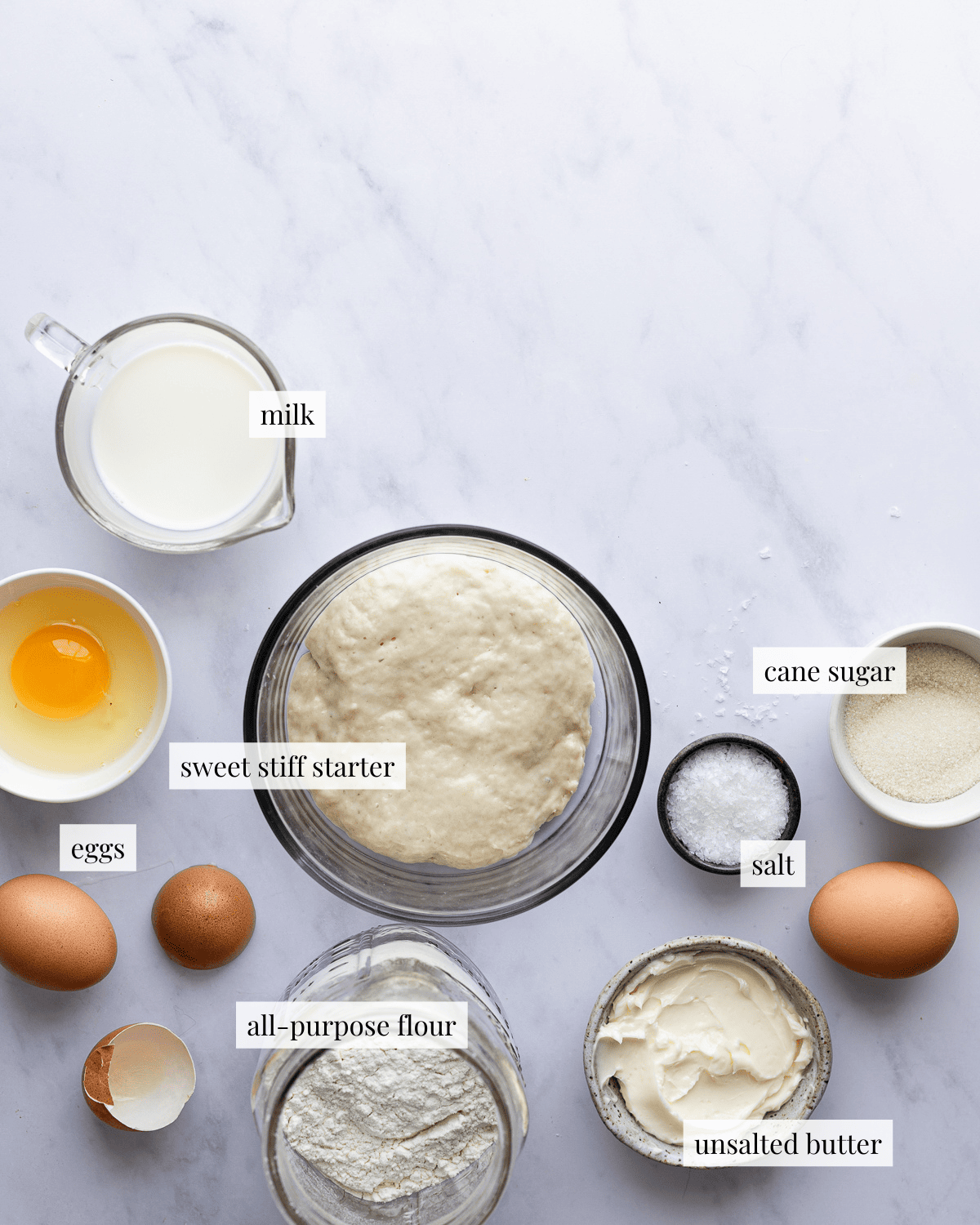
All-purpose: You can substitute bread flour but your rolls will be a bit chewier, don’t use whole wheat flour or your rolls may become dense and dry.
Milk: This recipe was developed using whole milk it adds richness and tenderizes the bread, substitute your favorite plant-based milk.
Cane sugar: I’ve been using organic cane sugar over granulated sugar because it's produced using more sustainable methods. I use it in almost all of my recipes, from my Sourdough Discard Chocolate Shortbread Cookies to my Sourdough Discard Soft Pretzels.
See recipe card for detailed ingredient list.
What is a sweet stiff starter?
Unlike a 100% hydration or liquid starter, a stiff starter has a higher flour content. Since most of the liquid in these rolls comes from eggs and milk, a low-hydration starter lets me manage the extra liquid I introduce into the recipe. It also allows for a larger proportion of starter in the dough, speeding up the rising process. The inclusion of sugar in the starter curbs bacterial activity and acid buildup, reducing sourness and resulting in sweet, fluffy, buttery rolls.
TIP: Using a mature, active sourdough starter is crucial when making enriched bread. A weak starter, would make fermentation occur too slowly potentially leading to acidification that breaks down the dough's gluten. This causes the dough to tear as it rises and prevents it from capturing and retaining the carbon dioxide produced during fermentation. The end result: dense, heavy, and gummy rolls.
Looking for more soft, fluffy bread recipes made with sourdough? Try my Sourdough Brioche Bread, Sourdough Japanese Milk Bread, Sourdough Babka, Sourdough Sticky Buns and Sourdough Monkey Bread.
Step-by-step process
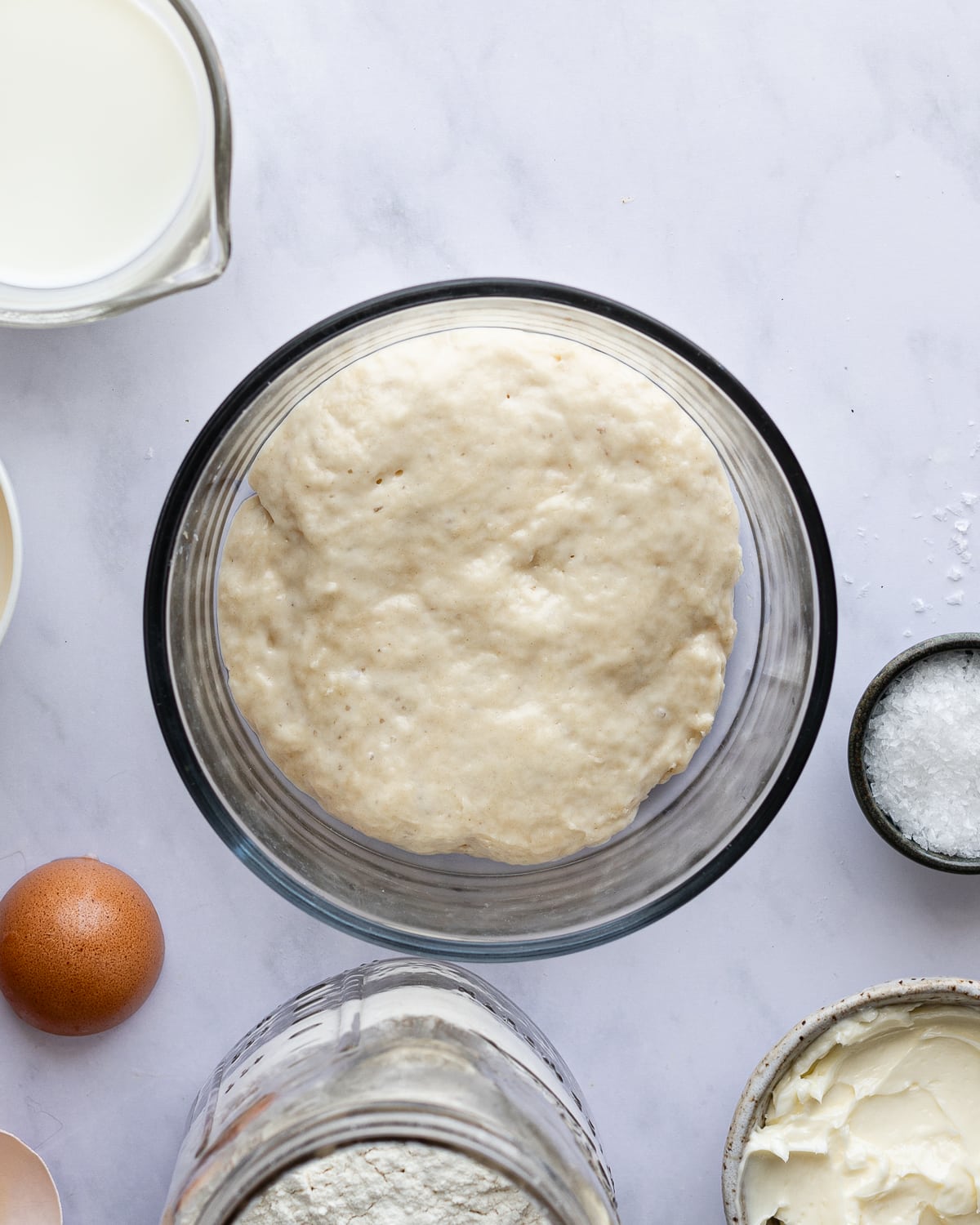
STEP 1: Make the sweet stiff starter
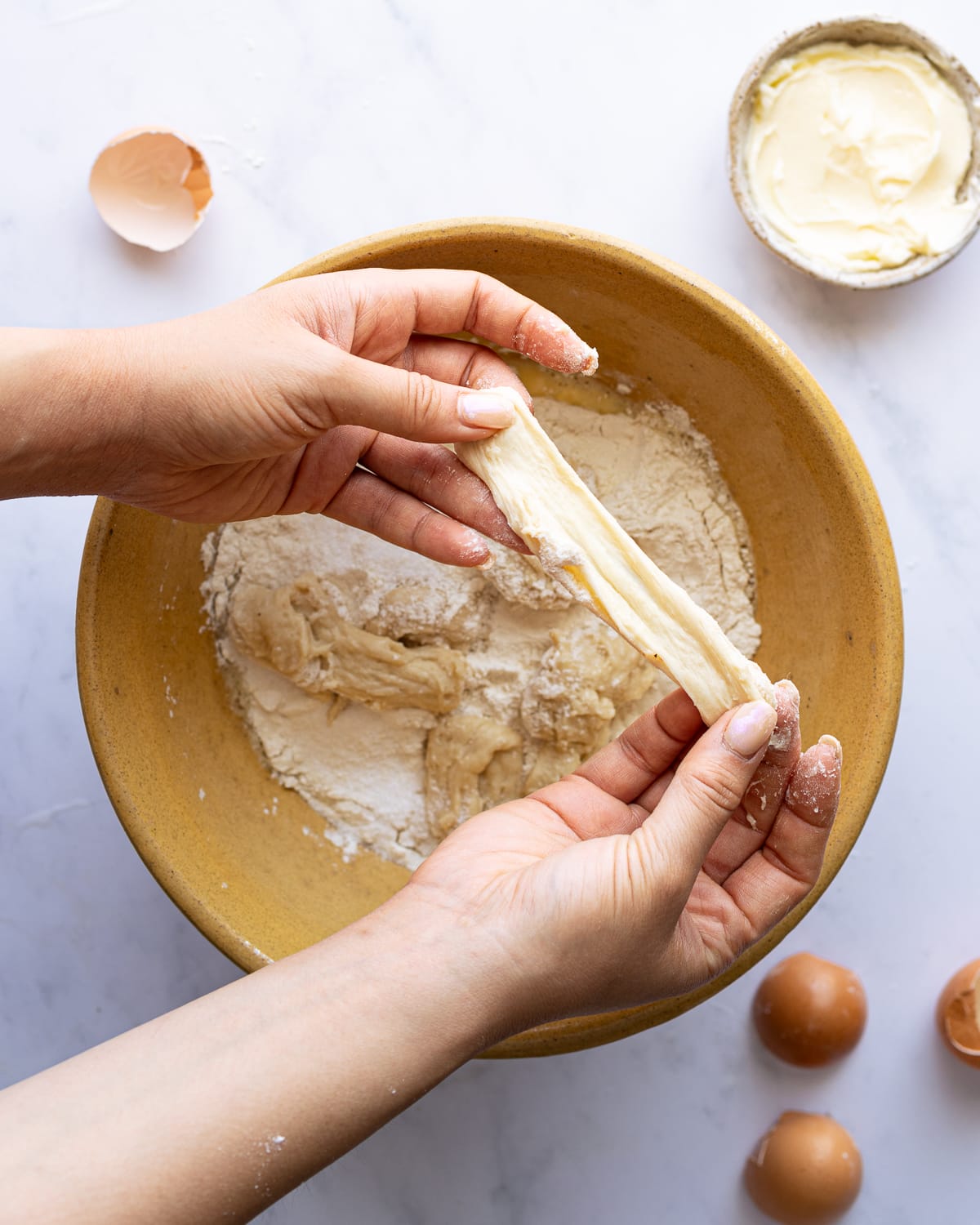
STEP 2: Mix all the dough ingredients together with the sweet stiff starter.
TIP: Make sure your starter is mature and active before trying this recipe or your dough may not proof properly, resulting in dense and gummy rolls.
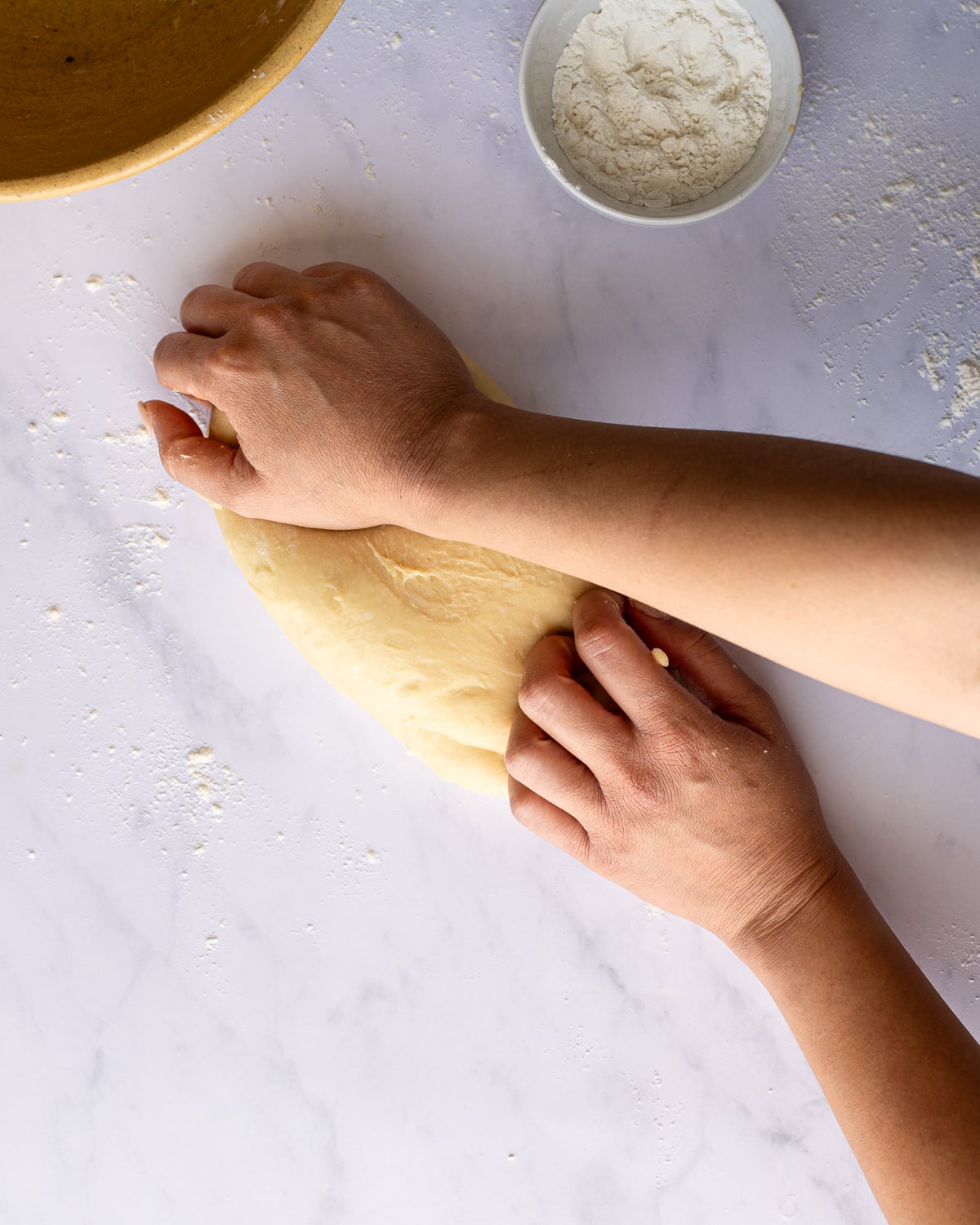
STEP 3: Knead the dough until it looks smooth and cohesive.
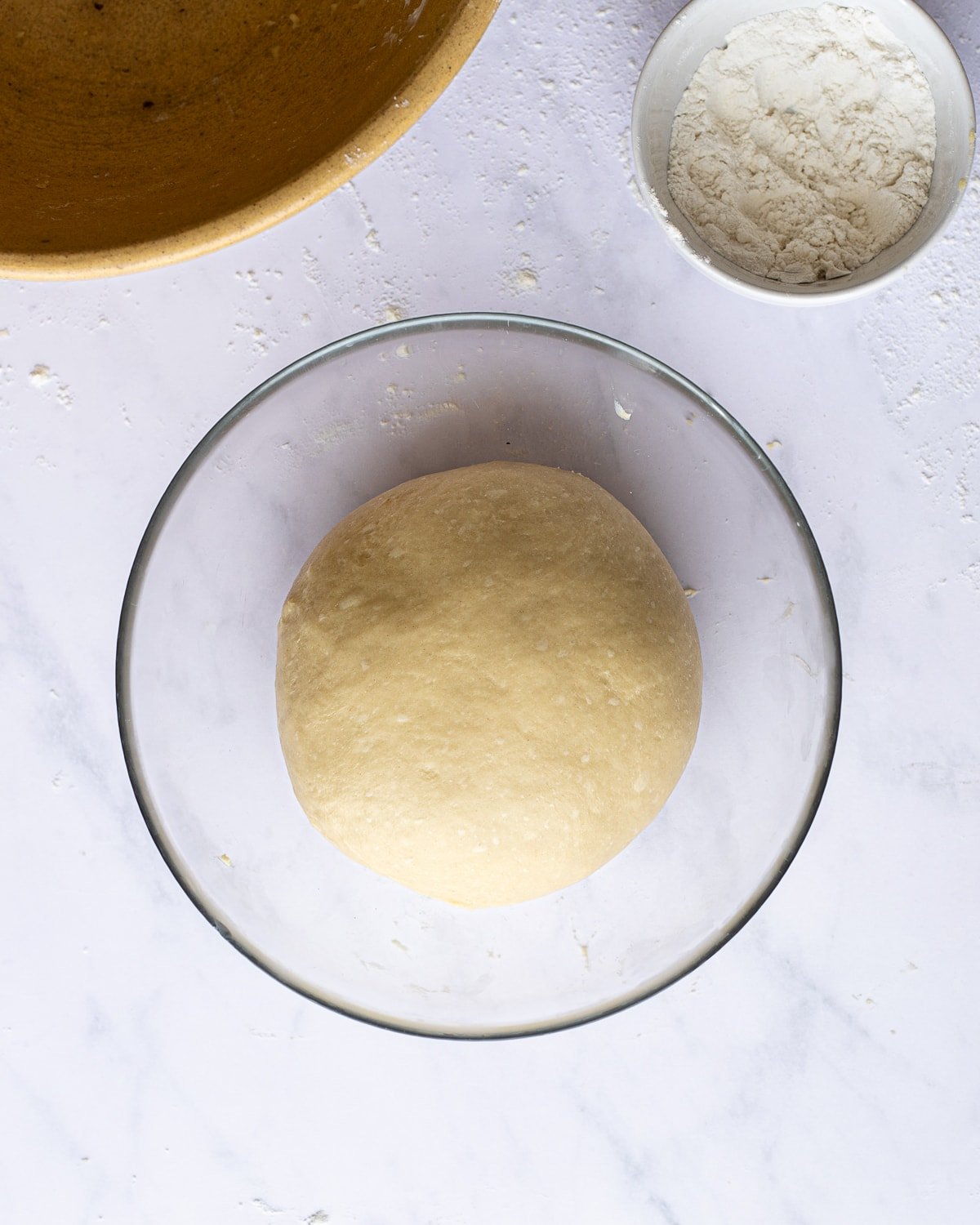
STEP 4: Allow the dough to rise in a warm place (>72 F) until doubled in volume.
TIP: Enrichments like eggs, milk and butter impart tenderness to bread but they the effect of slowing down fermentation. It's important to be patient. Wait until your dough has doubled in volume before shaping, this could take 4 to 6 hours.
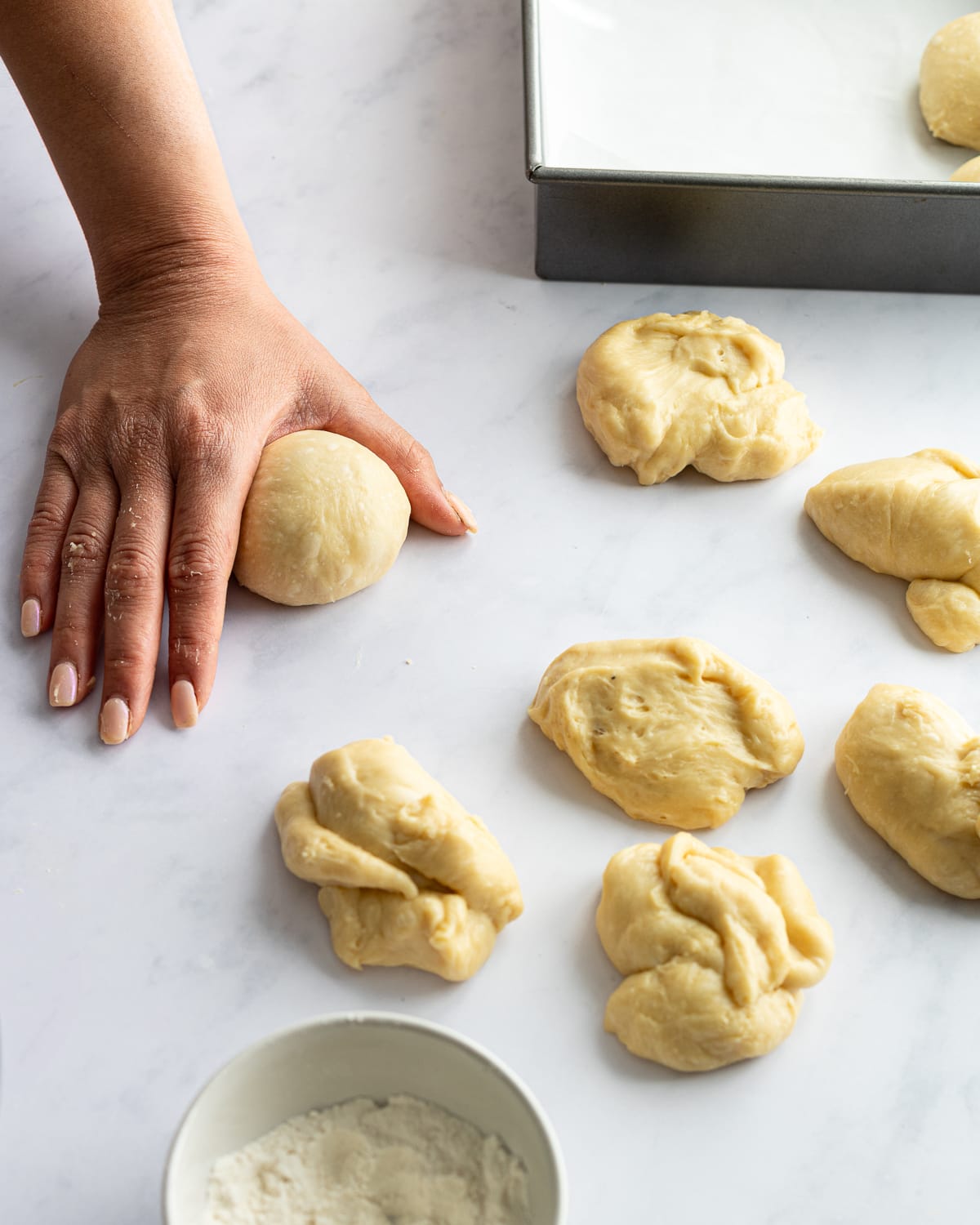
STEP 5: Divide the dough into 9 portions and shape them into tight balls.
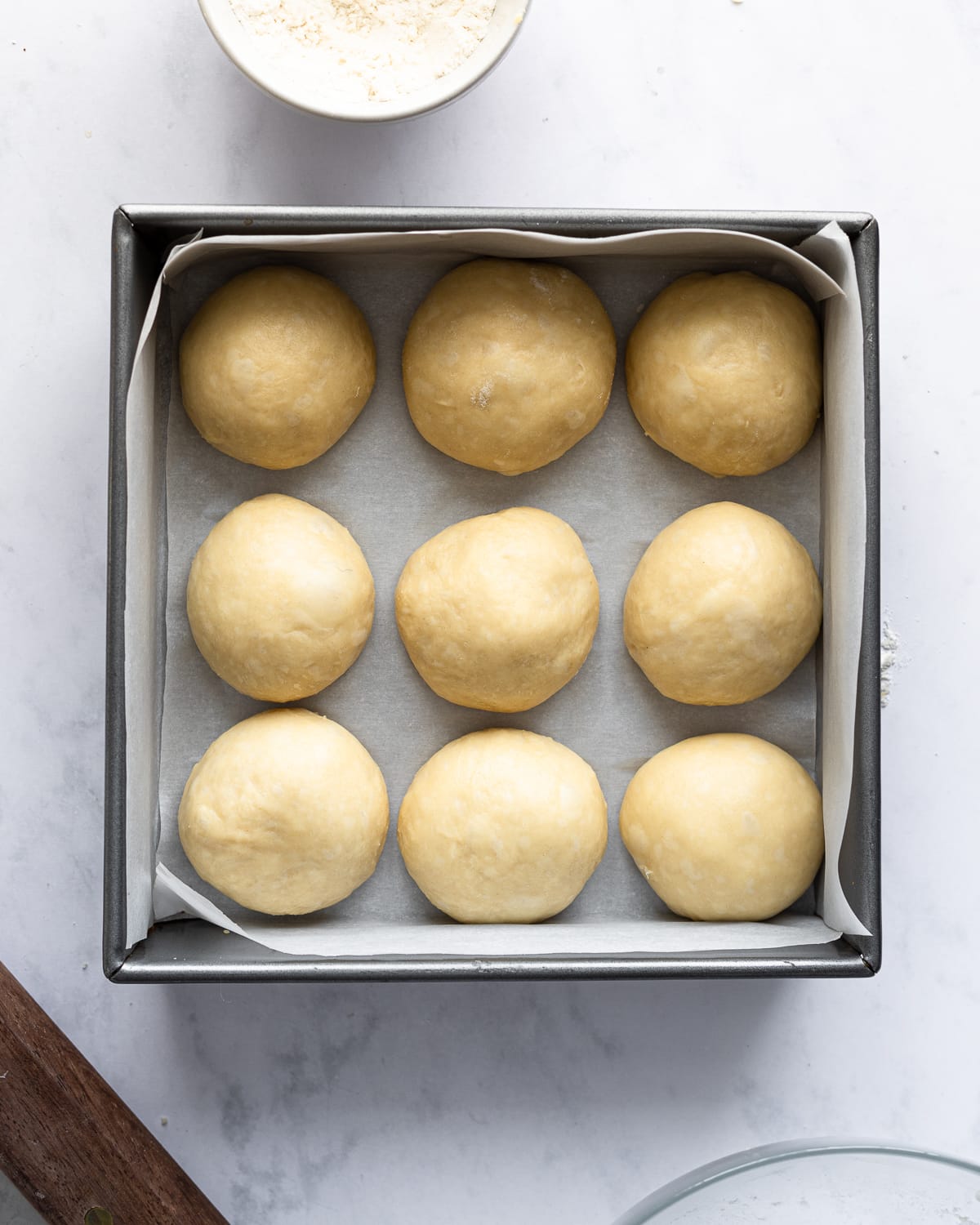
STEP 6: Cover the baking pan with plastic wrap and cold proof overnight.
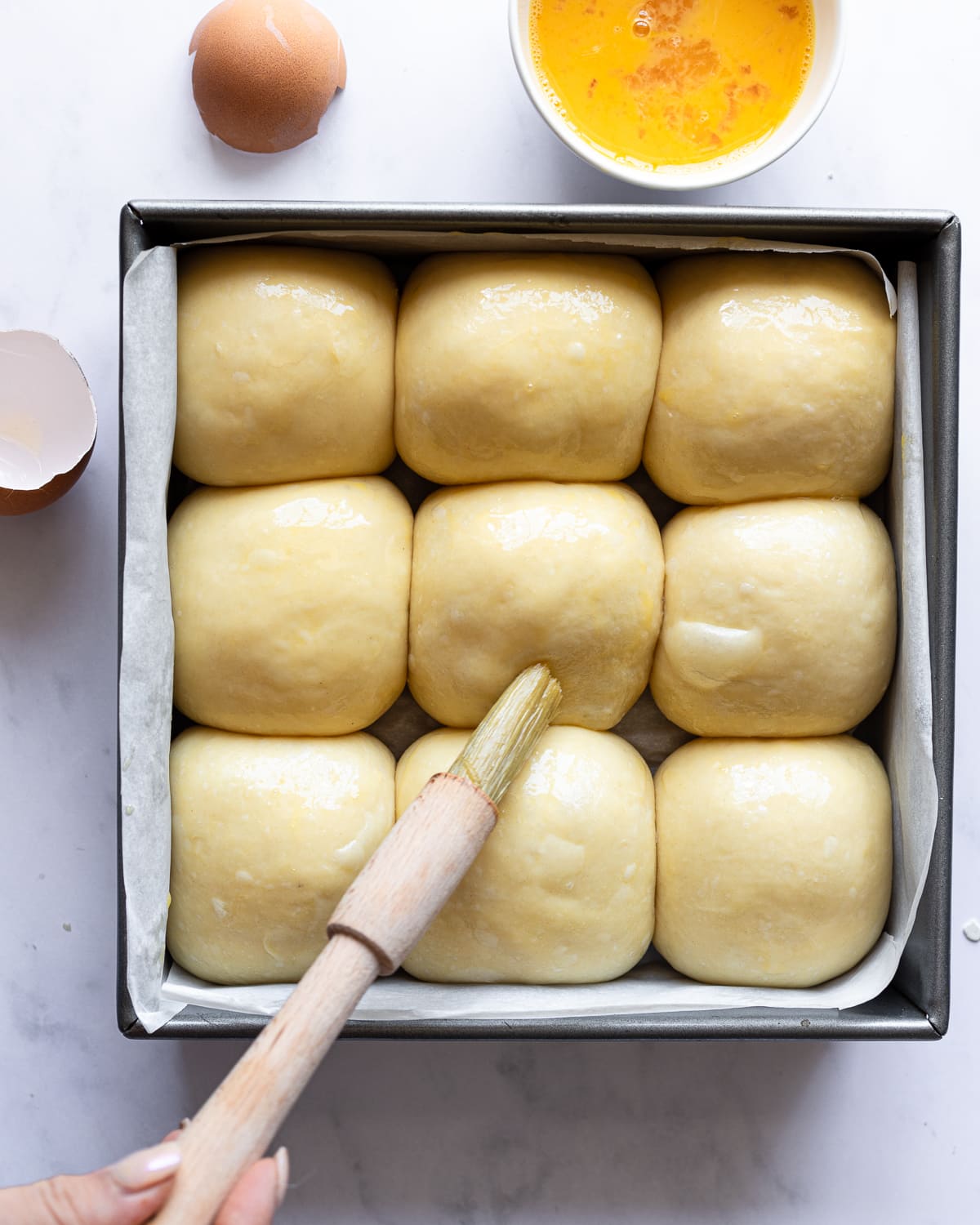
STEP 7: Let the dough rise until it fills the pan. Brush the dough with egg wash.
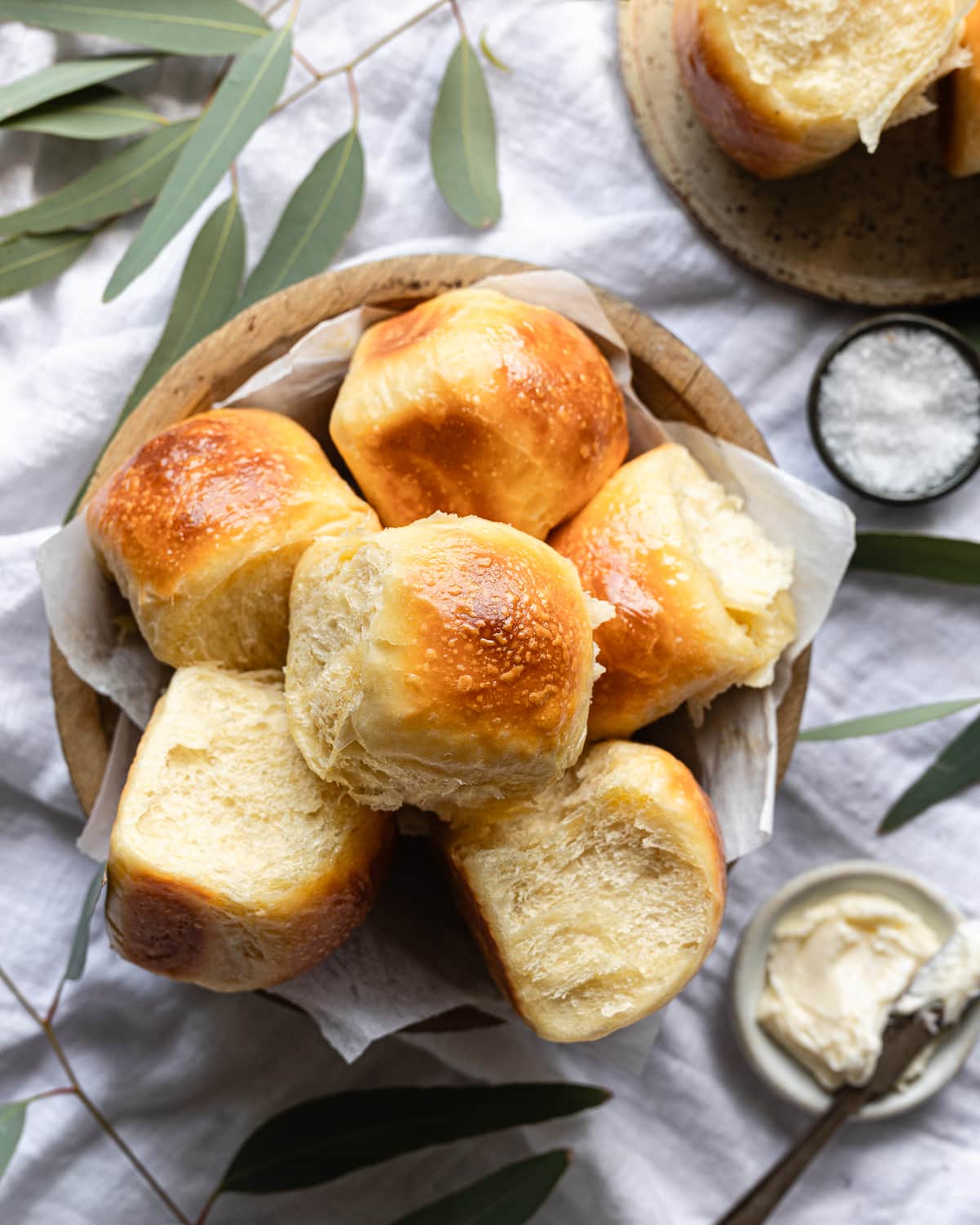
STEP 8: Bake at 350 for 20 to 25 minutes or until golden brown
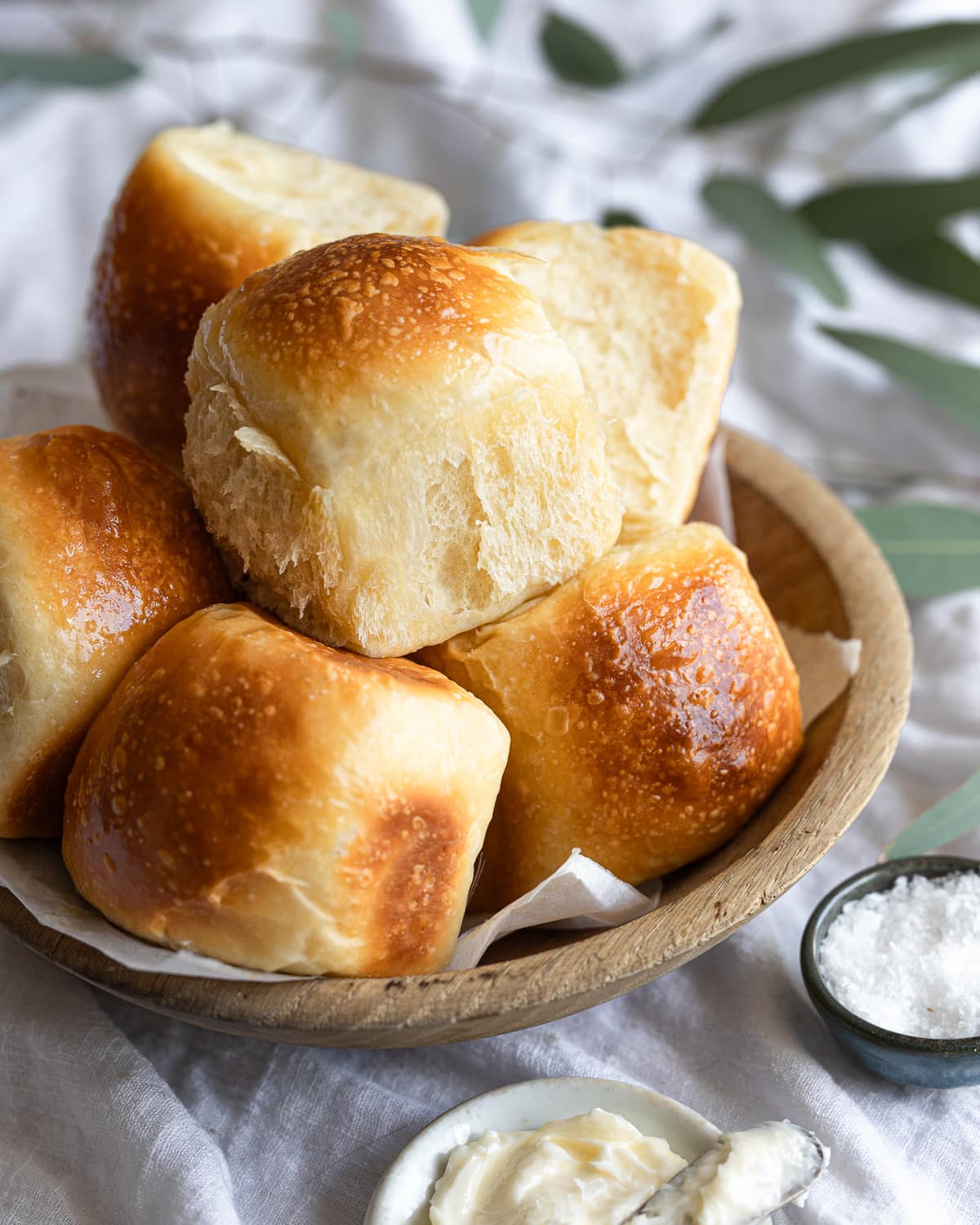
Baker's Tips
Knead the dough until smooth: Gluten development is essential for these rolls. A strong gluten network will allow the dough to capture and retain carbon dioxide during the fermentation process. This results in tender, pillowy rolls.
Let the dough rest before kneading: A short rest period allows flour to fully hydrate and makes dough easier to work with. If your dough feels too sticky at any point, stop kneading it let it rest for 15 minutes.
Bake the dough side-by-side: Baking the dough nestled together instead of as individual rolls prevent them from becoming too crusty and let them retain their pillowy texture on all sides.
Let the dough rise fully before baking: If your dough didn’t rise in the refrigerator, take the pan out and let the dough rise in a warm place. They should fill the pan before you bake them.
Brush the baked rolls with melted butter: Brushing the top of the rolls with melted butter softens the crust and imparts a rich buttery flavor to this bread. Take these rolls up a notch by brushing them with homemade honey butter.
Don’t refrigerate leftover rolls: The refrigerator has a tendency to dry out bread, it’s best to store any leftover rolls in an airtight container at room temperature.
Recipe FAQs
Your starter may not have been active. Make sure you use a mature starter before you make this recipe. The sweet stiff starter should look bubbly before you make your dough. If you’re baking in a cold kitchen, your dough may take much longer to rise. Try mixing your dough using warm water (less than 115 F) and allowing your dough to bulk ferment in a warmer spot, like inside the microwave or inside an oven that’s turned off but with the light turned on.
Yes! To use a mixer, combine the ingredients in the bowl of a stand mixer, use a paddle attachment to stir the ingredients together. Once the dough appears cohesive, switch to a dough hook and mix until the dough clings to the hook and away from pulls away from the sides. Round the dough into a ball and proof. Then proceed with the recipe as instructed.
These rolls are a great side for Thanksgiving or Christmas. You can also serve them with bbq, grilled meats, or as the base for breakfast sandwiches or sliders.
No, these rolls will taste buttery and slightly sweet. Using a sweet stiff starter helps prevent these rolls from becoming too acidic. A higher percentage of flour provides more nutrients to your starter and prevents it from producing too much acid. Furthermore adding sugar to sourdough creates osmotic stress and limits bacteria cell generation, which prevents further reduces sourness.
More sourdough bread recipes you'll love
Did this recipe rise to the occasion?
⭐⭐⭐⭐⭐
We knead your feedback! Did our recipe impress your taste buds? Leave a star rating and write a review to help us create even better recipes.
I read all the comments and love hearing your feedback.
Remember to PIN this recipe on Pinterest, so you can whip it up whenever cravings strike!
THANK YOU!
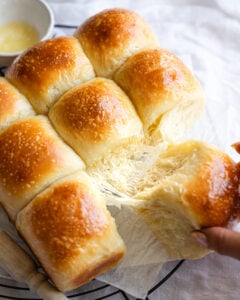
Sourdough Dinner Rolls Recipe
Equipment
- 8-inch metal baking pan
This section may contain affiliate links
Ingredients
Sweet stiff starter
- 60 grams all-purpose flour
- 28 grams water
- 14 grams cane sugar
- 14 grams sourdough starter mature
Dough
- 2 eggs large
- 113 grams whole milk
- 36 grams cane sugar
- 270 grams all-purpose flour
- 6 grams salt
- 56 grams unsalted butter softened
Toppings
- 1 egg
- 28 grams unsalted butter melted
Click US Customary to view volume measurements
Instructions
- Make the sweet stiff starter: Combine the sweet stiff starter ingredients together, stir until all the flour is hydrated, the mixture may appear a little dry. Continue mixing until it comes together into a shaggy dough. Transfer the starter to an airtight container, set it in a warm place, and let the starter activate overnight.60 grams all-purpose flour, 28 grams water, 14 grams cane sugar, 14 grams sourdough starter
- Make the dough: Whisk the eggs, milk, and sugar together in a large mixing bowl until no traces of egg whites remain.2 eggs, 113 grams whole milk, 36 grams cane sugar
- Tear the sweet stiff starter into small pieces and add it into the large mixing bowl with the flour and salt. Stir all the ingredients together until the mixture looks like a cohesive dough.270 grams all-purpose flour, 6 grams salt
- Knead the butter into the dough one tablespoon at a time, wait until each portion is incorporated before adding more. Cover the bowl with plastic wrap and let it rest for 1 hour.56 grams unsalted butter
- Strengthen the dough: Turn the dough out on a lightly floured work surface and knead until it appears smooth and elastic. Round the dough into a tight ball and place it into a clean, lightly-greased bowl.
- First rise: Cover the bowl with plastic wrap and let it rise in a warm spot until doubled in volume, about 4 to 6 hours.
- Shape the dough: Line an 8-inch square baking pan and line it with parchment paper. Divide the dough into 9 portions. Round each piece of dough into a tight ball and arrange them in your prepared pan.
- Second rise: Cover the baking pan with plastic wrap and transfer the dough to the refrigerator and proof overnight (8 to 16 hours).
- Prep: Remove the rolls from the refrigerator and set them on the counter. Preheat the oven to 350 F.
- Egg wash: Once the rolls look ready (they should look well risen, fluffy and fill the pan), beat the egg to make your egg wash. Using a pastry brush, brush the tops of the dough with egg wash.1 egg
- Bake: Bake the rolls for 20 to 25 minutes or until the rolls are golden brown and register at least 190 F when probed with an instant-read thermometer.
- Brush with butter: Remove the baked rolls from the oven and brush them with melted butter.28 grams unsalted butter
- Enjoy and store: These rolls are best enjoyed on the day they are baked. Store leftover rolls in an airtight container at room temperature for up to 3 days.
Tips
These recipes were developed and tested using grams for precise measurements. To increase your chances of success, I recommend investing in a kitchen scale. I've included rough volume estimates (in tablespoons and cups), but they might not be totally accurate.
Remember all ovens are unique, these recipes were tested in my oven which runs cooler than others. You might need to lower the temperature if your bake appears to be browning too quickly. Monitor your bake closely and make adjustments if needed.

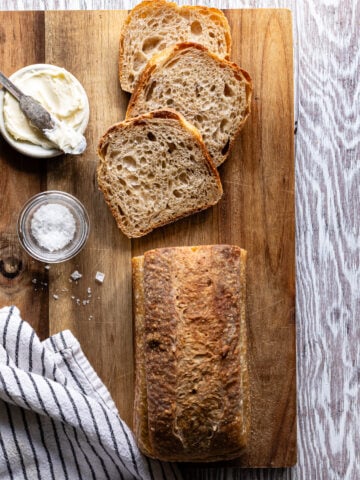
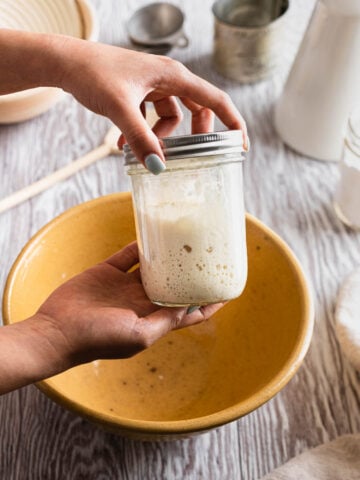
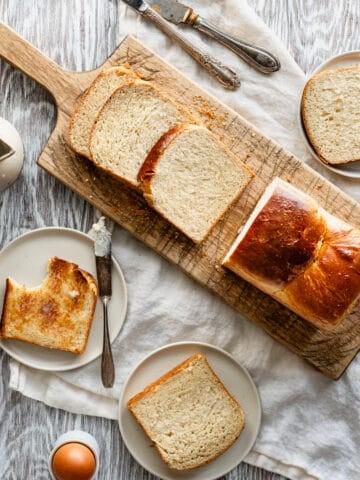
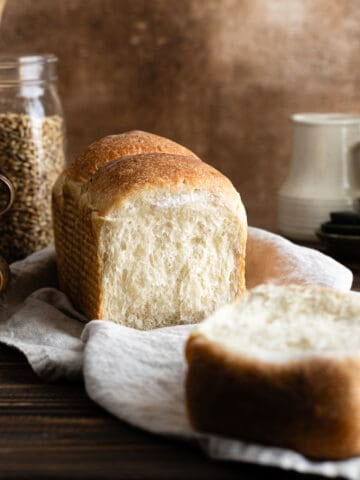
Catherine Desbiens Bolduc
J'ai fait une première tentative avec la recette telle quelle. la mie était dense, aucune activité observée avec la levure.
J'ai fait une 2e tentative avec des modifications. Ça a été un succès! De beaux rolls ronds, fluffy.
Voici ce que j'ai fait:
1-Dans une casserole, j'ai chauffer le lait avec le miel, le sel et le beurre jusqu'à ce qu'il soit fondu. J'ai laissé tiédir.
2- Dans un bol, j'ai mélangé les 2 levures. J'ai incorporé le mélange tiédi puis l'oeuf.
3- Dans un bol, j'ai mélangé les farines puis incorporer le mélange liquide.
4-J'ai suivi la méthode de base pour les levées et le "egg wash", sauf que j'ai fait la dernière levée dans des moules à muffins graissés.
5- J'ai fait cuire à 400 pendant 20 à 25 minutes.
Mes rolls étaient P.A.R.F.A.I.T! Miam!
Katie
What salt do you recommend using for the rolls? I was thinking of using Diamond Kosher Salt Flakes?
Hannah Dela Cruz
Hi Diamond Crystal is a great option! If possible, measure by weight so you can accurately measure the right portion of salt for the recipe.
Fran
First, cut the salt in half. Second, I needed WAY more flour. Took more than 24 hours to make with all the rising. You only use a tiny bit of starter, thinking it might have been faster if I'd had more starter.
Hannah Dela Cruz
Thanks for your feedback!
As always salt from different brands can impart different levels of flavor to the dough, however the salt in this recipe is about the standard 2% that bread doughs call for. I'm sorry that you thought it was too salty.
Fermentation can slow down drastically depending on the conditions in your kitchen. If you are baking in the northern hemisphere, it could be particularly slow because of winter and cold temps. Additionally, enriched bread takes A LONG TIME to make. It's loaded with butter and dairy which slow down fermentation even further. You could always try my sourdough discard rolls if you would like ones that come together quicker.
The small amount of starter is a seed for the stiff levain. By the time that you add the levain to the dough it's about 42% of the weight of the flour in the recipe. Adding anymore could acidify your dough and cause the gluten to break down.
Caitlin
These turned out amazing! So soft, fluffy, and the perfect level of sweetness. I wanted to make a few batches next week have you ever tried doubling or tripling recipe and baking larger batches at a time?
Hannah Dela Cruz
I'm so glad the recipe worked for you! Yes, this recipe will double or triple just fine.
Elisa
Can you make these ahead of time and freeze? Should you bake and freeze or freeze dough and then defrost and bake?
Hannah Dela Cruz
Hi - I'm not sure if this would work as I've never tried it! I don't usually freeze dough or bread so I can't speak on how this would affect the bake.
Alice
Can I make these rolls without overnight refrigeration? I want to limit the "sourness" of the dough, and I usually make my regular sourdough loaf bread without an overnight cold proofing. I love using "natural" yeast, but don't always want a "sour" taste.
Thanks
Alice
Hannah Dela Cruz
Hi Alice - absolutely! These rolls can be baked on the same day, I tend to break the process up since the first rise takes hours. Just be sure to watch the rise of your rolls. They should be very puffy and well risen before you bake them.
Alice
Hi Hannah,
I have frozen sour dough dinner rolls with good results. This is after they are baked completely and cooled.
Have you ever done that with this recipe?
Thanks!
Alice
Hannah Dela Cruz
Absolutely!